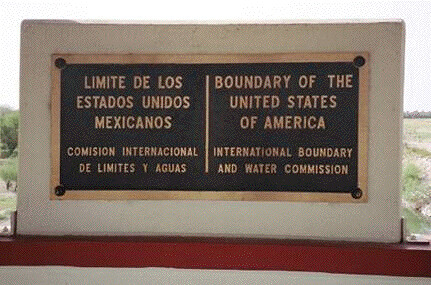USA: Illegal Immigrants: Immigration USA, not yesterday, but now - false historical analogies don't help
.
The Germans refused for decades to give up their native tongue and raucous beer gardens. The Irish of Hell's Kitchen brawled and clung to political sinecures. The Jews crowded into the Lower East Side, speaking Yiddish, fomenting socialism and resisting forced assimilation. And by their sheer numbers, the immigrants depressed wages in the city.The foregoing picture by Michael Powell, "US Immigration Debate is a road well travelled," Washington Post, May8,2k6, seems to have been constructed by the author to set up his line discourse intent to elaborate what that flood of "16 million immigrants" coming into the country thru Ellis Island "from 1882 to 1922" - perhaps the most famous point of entry of immigrants in world history - what it means now. Because now there's an even more reknown "point" of entry, or pointless chain of entries. It's a 1,900-miles-long border between Mexico and the the US (the border with Canada is ruffly twice the length).
As for the multitudes of Italians, who settled Mulberry Street, East Harlem and Canarsie? In 1970, seven decades after their arrival, Italians lagged behind every immigrant group in educational achievement.
The bitter arguments of the past echo loudly these days as Congress debates toughening the nation's immigration laws and immigrants from Latin America and Asia swell the streets of U.S. cities in protest. Most of the concerns voiced today -- that too many immigrants seek economic advantage and fail to understand democracy, that they refuse to learn English, overcrowd homes and overwhelm public services -- were heard a century ago. And there was a nub of truth to some complaints, not least that the vast influx of immigrants drove down working-class wages.

Photo by Lacey Dodge©May9,2k6
That's the problem with Powell's account. We wants to distract the conversation to historical analogies that no longer hold.
One of his later themes elicits more candor from Powell. The contrast between a multitude of foreign-language enclaves in the Ellis Island civilization of New York then, and the singular language-community and homogenic non-American cultural signature of the Mexicans, illegals and legals together. Notice the sentence set off by parentheses in what follows.
Americans worried about the primacy of English at the turn of the 20th century, most first-generation immigrants quickly shed native languages -- in polyglot New York no single language could dominate. This remains true as the three largest immigrant groups -- Dominicans, Chinese and South Asians -- share no language but English. (The vast Spanish-speaking Mexican influx into Southern California is another matter and potentially more problematic as immigrants have less incentive to drop a shared language, say sociologists.)The article is quite interesting to a person with the socialogical and anthroplogical interests I have; and the multi-ethnic good will that makes me a happy resident of Toronto, where I live in a multi-ethnic neighbourhood of immigrants and skin-colours galore, and where I rent from a young Chinese couple (with a little girl and another kid on the way). The parents themselves immigrated from Communist China.
But the current Mexican immigration into the US is another thing entirely, one side of it is legal and orderly. As such it involves planning the faclities of welcoming, education, and health, and teaching of English as a Second Language - all of which can be projected in terms of the numbers of newcomers according to the rules, cost-accounted, and prepared for. Illegal immigration is another matter entirely.
Toronto is enriched by Hispanic immigrants communities from all over Latin America (and other communities from all over the Carribbean as well). I enjoy dining, at the invitation of friends, in one or another of several Mexican-cuisine restaurants in the city. I like lots of Mexican music. I admire the folkloric arts and the great mosaics that typify Mecican culture most to me, and the tradition of powerful modernist painting in Mexico.
After English and French, I know a bit of Spanish grammar, so can read-and-guess my way thru some news articles. I've read a stack of Hispanic novels in translation, and have lived with a few poems by a handful of Latin American poets - preferring bilingual editions so that I can sound out the Spanish and try to catch in the inherent rhythm and in workmanship of any rhyming the flow of sounded-ideas in the original. That way, you get to "see thru" the various translations of a given poem, to favour one as the best, even come up with your own version of a few lines that are especially uncanny in metaphor and taste.
For such reasons, I can see at least some schools in some areas of the US offering Heritage Langauge courses in Spanish to legal Mexican immigrants and other other Hispanic legals. But up until one is 26, one has the best chance, neurologically speaking, to hear and talk English well, languge-learning should be emphasized. From first grade thru twelve, immigrant children and the children born in the USA to immigrant parents should be learning English (in Canada, either English or, in Quebec, French, later on perhaps English too).
Illegal immigration is another matter. And it has much to do with the failure of Mexican business which desperately needs new blood, new capital investment from the USA and Canada, and new styles of business culture - all motivated by offering employment to Mexicans in Mexico. Without this latter idea coming to realization, the mass illegal immigrant flood will not stop. More on these matters later. - Politicarp
For further reflection:
• The best immigration reform Stimulating growth south of the border
• Mexico's Presdient Vincente Fox predicts Nuevo Laredo drug backlash


No comments:
Post a Comment